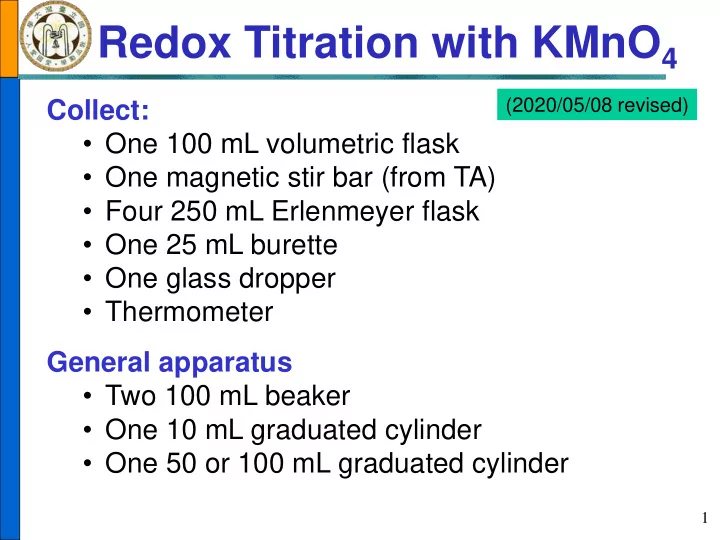

Redox Titration with KMnO 4 (2020/05/08 revised) Collect: • One 100 mL volumetric flask • One magnetic stir bar (from TA) • Four 250 mL Erlenmeyer flask • One 25 mL burette • One glass dropper • Thermometer General apparatus • Two 100 mL beaker • One 10 mL graduated cylinder • One 50 or 100 mL graduated cylinder 1
Principle - Standardization Standardization of KMnO 4 (aq) with Na 2 C 2 O 4 2- (aq) + 16H + (aq) - (aq) + 5C 2 O 4 2MnO 4 2Mn 2+ (aq) + 10CO 2 (g) + 8H 2 O(l) McBride method Titrate with KMnO 4 at 60~90 o C with stirring The first persistent (ca. 30 s) pink color as the end point Fowler-Bright method At room temp., add 80% KMnO 4 to react with Na 2 C 2 O 4 - disappears Stir until the purple color of MnO 4 Heat the solution to 55~60 o C then complete the titration 2
Principle - Analyze the Iron(II) Content Determine the percent composition of iron(II) in an unknown sample with standard KMnO 4 solution 8H + (aq) + MnO 4 - (aq) + 5Fe 2+ (aq) 5Fe 3+ (aq) + Mn 2+ (aq) + 4H 2 O(l) n Fe2+ n MnO4 − = 5 1 3
Step 1 Preparation of 0.02 M KMnO 4 Weigh about 0.3 g KMnO 4 (s) Dissolve the solid with deionized water Dilute to 100 mL with volumetric flask 4 Dissolve the solid completely
Step 2 Standardization by McBride Method (1) • Heat to ca. 80 o C Weigh 0.1~0.15 g (to the • Titrate with KMnO 4 till Dissolve with 50 nearest 0.1 mg) Na 2 C 2 O 4 mL 1 M H 2 SO 4 the pink color persists into 250 mL flask 30 s to the end point (2) Blank titration : titrate 50 mL 1 M H 2 SO 4 at 80 o C 5
Step 3 Standardization by Fowler-Bright Method • Heat to 55~60 o C (1) • At room temp. • Titrate with KMnO 4 Weigh 0.1~0.15 g Na 2 C 2 O 4 • Add ca. 80% KMnO 4 into 250 mL flask till the pink color • Stir until appears Dissolve with 50 mL of 1 M persists 30 s to the colorless H 2 SO 4 end point (2) Blank titration : titrate 50 mL 1 M H 2 SO 4 by same procedures 6
Step 4 Determine the Percent Composition of Iron(II) Unknown sample that contain Fe(II) Odd no. explores unknown A; even no. examines unknown B Incubate for 3 min. (1) Weigh ca. 0.2 g • Add 10 mL Z-R Add 5 mL conc. HCl Titrate with unknown sample and heat to nearly reagent and KMnO 4 in the flask boiling 100 mL H 2 O (2) Blank titration : titrate blank solution (without unknown sample) by 7 same procedures
Notice Condensed report Manipulate the volumetric flask Use funnel to transfer the solution Use a dropper to bring the liquid level to the mark Remove the buret away from top of the hot plat while not doing the titration to avoid heating the solution in buret Heat the conc. HCl(aq) in fume food Put the cotton gloves on to remove glassware from heating Dispose the waste into heavy metals waste container Calculation: Correct the titration data for the blank Calculate [KMnO 4 ] by McBride method Calculate [KMnO 4 ] by Fowler-Bright method Calculate the percent composition of iron in unknown sample 8
T9 - Electronic Balance T9 Video on YouTube (Click) Place balance on stable, non-vibrating table where no sun/wind, and temperature is stable. Do not overload the balance. Maximum load of an electric balance in lab is 610 g. Make sure balance is level, clean, and dry before use. Warm up the balance for 30 minutes before use. Put weighed object in the center of weighing pan. A baked object need to go back to room temperature before weighing, the buoyancy of convective airflow around the pan Analytical Balance will affect object’s apparent mass. (s.f. contains four decimal places) Wipe balance clean with a damp cloth but do not use solvents. Do not invert balance upside down to avoid damage to the parts inside. Use folded paper, beaker or bottle as container while weighing, do not put chemicals on directly. Analytical balance is a more precise balance having maximum load of 210 g, close its windshields while zeroing and weighing or the reading is inaccurate. 9
T13 - Volumetric Flask T13 Video on Youtube (Click) Wash a 100 mL volumetric flask 標線刻度 Mark thoroughly and rinse with distilled water. Transfer the solution to flask with the In ml help of a funnel. 100 ± 0.15 o C 20 Fill the flask about half full and swirl the contents to achieve solution. Bring the liquid level almost to the mark. Use a dropper to add solvent to the mark. Stopper the flask and invert repeatedly to assure homogeneous. Pour the solution in beaker for later use. Wash immediately after use. 10
T14 - Titration T14 Video on Rinse a 25 mL-buret with D.I. water thoroughly. Youtube (Click) Rinse twice with ca. 5 mL titrant. Transfer the titrant to buret via funnel. Drain slowly until the tip is free of air bubbles and completely filled with liquid. Read and record initial (V i ) and final volume (V f ) of buret to 0.01 mL. Place buret tip well inside the receiving flask during titration. Swirl the flask with right hand and control the stopcock with left hand (process done by one person). Rinse the buret with tap water, inverted clamped, and left to dry after the experiment. 11
Recommend
More recommend